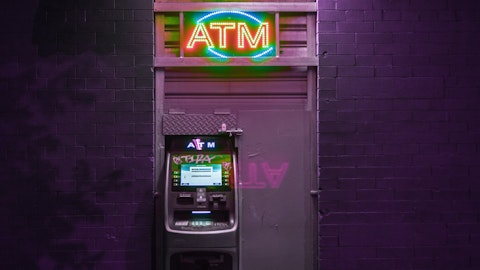David Turner: Yeah, I think so what’s baked into what I just told you is that we would have a beta through the end of this year pushing on 40%, maybe a little underneath that. And then we go into perhaps the mid-40s into next year. And again, that’s considering higher for longer. It starts to slow there, again, because we don’t have as much moving out of non-interest bearing into interest bearing. So I think the – again, if we have rates even that continue to go up, we’re slightly asset sensitive, and the re-pricing of our balance sheet starts to overwhelm the deposit moves, and I think that’s a piece that people might not be picking up on.
Scott Siefers: Okay. All right, wonderful. Thank you very much.
David Turner: You bet.
Operator: Your next question comes from the line of Ryan Nash with Goldman Sachs. Please proceed with your question.
David Turner: Good morning.
Ryan Nash : Hey, good morning guys.
David Turner: Hey.
Ryan Nash : Maybe to ask a question on credit, first, maybe just to clarify the implied a little bit above 35 for the year, which I guess implies around 45 for the fourth quarter. So that push is reported up to about 60 with GreenSky. Just wanted to verify that. And then, can you expand on the comments regarding what you’re seeing in office, multifamily, and maybe what happened with EnerBank, which I think you referenced higher charge-offs and exiting some parts of the portfolio?
David Turner: Yeah. So, you want me to start?
John Turner: Yeah.
David Turner: So yeah, I think that we’ll see some increase. So, let’s keep the GreenSky piece out, because that’s going to be noise. We kind of announced that separate. Go back to kind of core charge-offs, we said it would be slightly higher than 35. Call that a couple of points, maybe 37, which implies a fourth quarter in that 40 basis point charge-off range. We will continue to see elevated charge-offs coming through EnerBank, for which we provided this past quarter, relative to our program that we discontinued, and so we’ll see that for a quarter or two, and that’s factored into the guidance that we’ve given you. From an office standpoint, our office continues to decline. Even in October, I think we put that in our notes.
John Turner: Outstanding continues to decline, the quality of the portfolio.
David Turner: Outstanding, sorry.
John Turner: Maybe I’ll speak to that. With respect to office, we’ve got about $1.6 billion in outstandings. To David’s point, that represents some decline, pay downs, refinances over the course of the last quarter. As we said before, about 39% of that portfolio is in credits direct to single-tenant credits, and the bulk of that is to investment-grade quality tenants. The balance of our exposure, 61-plus percent are in multi-tenant credits, 63% of that is in the Sunbelt market, 92% is Class A, we have in total about 100 borrowers. So we are very much on top of the portfolio, having ongoing conversations with customers. About 50% of our exposure matures this year and in 2024, so we’re actively working that. One of the, I think, good signs about the portfolio is that sponsors have contributed over the course of the last couple of quarters, over $150 million to the projects.
Most of them are unguaranteed. So those are commitments that sponsors are making to the continued renewal extension of those projects, the right sizing of them. And as a consequence, we feel good about our office exposure. We have one non-accrual, and that credit has been renegotiated and is paying as agreed currently. With respect to – yeah… [Multiple Speakers]



